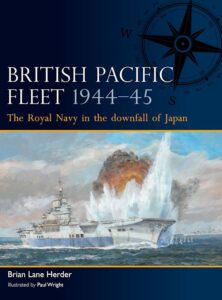
by RNS | Dec 10, 2023 | Beating Tsundoku
Brian Lane Herder, British Pacific Fleet 1944-45 (Osprey, 2023)
Victory in the Pacific in 1945 is largely remembered as a US Navy success, and rightly so; but the Royal Navy played its part too, providing carriers and other warships to the final campaigns to defeat Japan. In this volume of Osprey’s Fleet series, Brian Lane Herder takes readers inside the British Pacific Fleet to examine how it impacted those late war naval operations.
Herder begins with the British Pacific Fleet’s purpose, which was to serve as a Task Force alongside the US fleets that were steadily reducing the Japanese war machine across the Pacific. This was a somewhat reluctant marriage because of differing Anglo-American political agendas, but once military objectives were apportioned by the end of 1944, the Royal Navy was soon underway. Herder surveys the ships that took part in the British Pacific Fleet with the fleet carriers taking pride of place, though they were ably supported by light carriers, battleships, cruisers, destroyers, and submarines. Herder notes that the crews included Commonwealth sailors. He also reviews the variety of warplanes the RN carried, including the superior US planes such as the Corsair and Hellcat. How the fleet cooperated with the Americans follows, with Herder considering command, formations, communications, logistics, and the roles of maintenance carriers along with escort and convoy carriers – the fleet formations are accompanied by excellent graphics. Herder annotates the actions the BPF undertook in Operations Robson, Iceberg, and Inmate, and their part in the naval siege of Japan in July-August 1945. This includes accounts of the fighting, with the kamikaze attacks standing out as arguably the most terrifying moments a sailor can endure. In his analysis of the BPF, Herder praises the men while blaming Churchill for the late arrival of the fleet and its relative unpreparedness.
Herder writes well and provides his readers with an informative overview of the British Pacific Fleet. He packs a lot of detail into a short introductory book but adds a useful bibliography for further exploration. Herder also does a very good job of placing the fleet in its military and political context without losing sight of the immediacy of the situation the men and ships encountered against a beaten but not yet defeated enemy. It is clear from Herder’s account that the Royal Navy played a significant role in the final demise of Japan. Overall, this is another excellent addition to the Osprey Fleet series.

by RNS | Dec 7, 2023 | Beating Tsundoku
Michael John Claringbould, A6M2/3 Zero-Sen (Osprey, 2023)
The Japanese Zero must be high on the list of iconic WWII warplanes. It is also one of the most written about. However, in this book in Osprey’s Dogfight series, Michael John Claringbould surveys the aircraft, the pilots that flew it over the Solomon Islands in 1942, and their tactics to produce a fascinating account of a small but important slice of the War in the Pacific.
Claringbould begins abruptly with a detailed account of a mission flown by the Japanese in New Guinea in February 1942. Then he sets the scene with the origins of the land-based Zero-sen unit at Rabaul. Their original function was as a bomber escort but soon became a separate fighter unit. They were also quickly occupied in dogfights with American bombers and fighters. Aerial combat intensified from May 1942 with many losses on both sides. Lack of navigational aids caused more losses for the Japanese. Claringbould introduces us to some of the Zero pilots, an elite group of individuals and not the automatons of popular culture, he argues. They were well drilled but those that remained inflexible in combat often failed to survive. To that end, the seven month campaign over Guadalcanal whittled down the cadre through combat and poor health. Stress also took its toll. By the end of 1942, they were severely depleted. Claringbould turns to the planes these men flew, beginning with the Zero’s origins and proceeding through development, tactics, weapons, and maintenance. The author then takes a deeper dive into tactics. The Japanese discovered that their tactics honed over China needed to adapt for missions over the Pacific, partly because of the range of combat actions they had to undertake. Claringbould notes, however, that there were never enough planes or properly trained pilots once combat attrition took hold. He then picks some instructive combat stories to show the variety of Zero operations, including a detailed accounts of dogfights with American Kittyhawks and other US aircraft.
The combat descriptions are the highlight of Claringbould’s somewhat truncated overview of the Zero in action. The stories of how the pilots adjusted to the conditions over the Solomons makes the book worth reading, and Osprey’s excellent illustrations of Japanese tactics works well with those accounts. Claringbould also clearly knows his material inside out, though there are points where he could have excised some of the detail, and I felt that he struggles to talk down to his less knowledgeable readers. That isn’t helped by the lack of an introduction or conclusion; Claringbould pitches his readers straight into the action, works his way through some of the background information you need, more combat stories, then he stops, leaving the reader with many questions. That, of course, may be a positive, but overall Claringbould’s book reads like a chapter taken from a longer work. Otherwise, this slice of WWII combat was an illuminating and insightful study of pilots at war.



